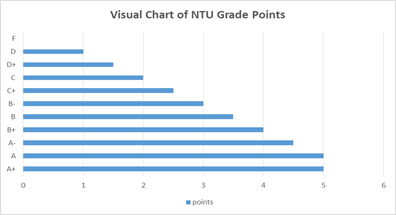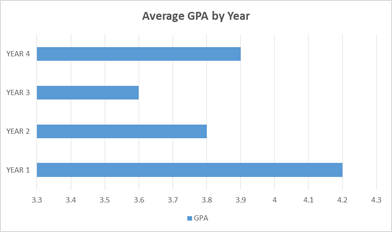Before we jump into grades and figures, let’s talk about something every student cares about. Yes, we are talking about marks. They are more than just numbers on paper. This has a strong effect on your internships, literacy, and, indeed, your dream job.
Now, if you study at Nanyang Technological University (NTU) in Singapore, you may also know that the grading system can be relatively confusing in the morning. Some of the grades, such as A or B, may feel familiar. Still, NTU also uses special grade points, including GPAs and groups, which can be confusing.
- Why is this important?
It is important because it helps you plan effectively when you understand how your grades are calculated. You will know when to push harder, when to maintain, and when to relax a bit. Think of it like a game; if you know the rules, you can play to win.
This guide is here to make things super easy. No complicated academic language. Simple points to help you understand exactly how NTU grades work.
- We’ll cover:
- What the NTU grading scale looks like.
- How GPA is calculated.
- What each grade means.
- Tips to keep your grades high.
- Bonus chart, table, and graph for quick understanding.
So grab your notes or just bookmark this page. By the end, you will understand your grades like a pro and will feel ready to say,” Now I know how to beat the system!”
Understanding the NTU Grading Scale
NTU uses letter grades with corresponding grade points. Here’s a quick look:
| Letter Grade | Grade Point | Description |
| A+ | 5.0 | Excellent |
| A | 5.0 | Excellent |
| A- | 4.5 | Very Good |
| B+ | 4.0 | Good |
| B | 3.5 | Good |
| B- | 3.0 | Above Average |
| C+ | 2.5 | Average |
| C | 2.0 | Pass |
| D+ | 1.5 | Borderline Pass |
| D | 1.0 | Poor Pass |
| F | 0.0 | Fail |
- Note: A+ and A have the same grade point (5.0), so aiming for A is already top-tier.
- Visual Chart of NTU Grade Points

How GPA is Calculated
Your GPA (Grade Point Average) is the sum of (Grade Points × Course Credits) ÷ Total Credits.
- Example:
| Course | Credits | Grade | Grade Point | Points Earned |
| Math | 3 | A | 5.0 | 15.0 |
| Science | 4 | B+ | 4.0 | 16.0 |
| English | 2 | C+ | 2.5 | 5.0 |
| Economics | 3 | A- | 4.5 | 13.5 |
Total Credits = 12
Total Points = 49.5
GPA = 49.5 ÷ 12 = 4.125
GPA Chart for Easy View
| GPA Range | Classification |
| 4.5–5.0 | First Class (Excellent) |
| 4.0–4.49 | Second Upper (Very Good) |
| 3.5–3.99 | Second Lower (Good) |
| 3.0–3.49 | Pass with Merit |
| Below 3.0 | Pass / Fail Risk |
Why GPA Matters
- It affects your scholarship eligibility.
- Employers check this when you apply for internships.
- It helps you determine if you need additional assignment help to strengthen weak areas.
Tips to Keep Your Grades High
Here are some tips that will help you keep your grades high.
- Know the Rubric
Each subject has marking rules. Learn them.
- Plan Your Study Time
Don’t leave work until the last night.
- Ask for Feedback
Teachers can guide you on where you lost marks.
- Use “Do My Assignment” Services Wisely
Get help from service providers, who act on requests like “do my assignment“, if you are stuck, but learn from it.
- Practice Past Papers
NTU often follows similar question patterns.
- Average GPA by Year

| YEAR | GPA |
| Year 1 | 4.2 |
| Year 2 | 3.8 |
| Year 3 | 3.6 |
| Year 4 | 3.9 |
Quick Grade Improvement Hacks
- Attend lectures (even when tempted to skip).
- Take short notes instead of copying slides.
- Join study groups; others may explain better.
- Submit assignments early for feedback.
- Ask seniors for past assignments and exam tips.
How to Use the NTU Grading System Wisely
Knowing the grades is one thing. Using them to plan your study is another. Here’s how you can use the NTU system to stay on track.
- Set a Grade Goal for Each Subject
- Look at the Grade Point Table
- Choose the grade you want for each subject
- Plan your study hours accordingly
- Target vs. Current Grade
| Subject | Current Grade | Target Grade | Extra Study Hours Needed |
| Math | B (3.5) | A (5.0) | 5 hrs/week |
| Physics | C+ (3.0) | B+ (4.0) | 3 hrs/week |
| English | A- (4.5) | A (5.0) | 1 hr/week |
- Watch Your GPA Early
If your GPA has dropped too much, then it becomes hard to fix it later. Check your grades from time to time.
- Simple Tip:
A GPA above 4.0 usually means you’re doing very well.
- Know How GPA is Calculated
NTU uses Grade Points and Course Credits to find your GPA.
- Formula:
GPA = Total (Grade Point × Course Credit) ÷ Total Course Credits
- Example:
| Course | Grade | Grade Point | Credit Points Earned |
| Math | A | 5.0 | 15.0 |
| Physics | B+ | 4.0 | 12.0 |
| English | A- | 4.5 | 9.0 |
GPA = (15 + 12 + 9) ÷ 8 = 4.5
- Use Support if Needed
If grades are low, ask for help early. This is where my assignment services or assignment help platforms can give you extra support. They can help you manage deadlines and improve your scores.
- Visualise Your Grade Progress
Here is a chart that shows GPA progress over semesters
| Semester | GPA |
| Year 1 S1 | 3.8 |
| Year 1 S2 | 4.2 |
| Year 2 S1 | 4.5 |
| Year 2 S2 | 4.7 |
Some Exquisite Tips
- Always check the grade point value for each letter grade.
- Plan study hours based on the gap between your current and target grade.
- Opt for online services if you are stuck.
- Review past test papers.
- Stay consistent rather than cramming at the end.
Conclusion
The NTU grading system may look scary at first. But once you understand the scale, GPA rules, and how grades link to your future, it gets easier. Think of your grades as a chart. They tell you where you are and where you need to go. However, get help when needed, and use the grading system to your advantage. This will only happen if you plan well. So keep learning, keep asking questions, and flash back. Grades are important, but they’re just one part of your academic journey.

